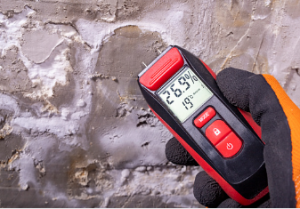Updated on July 31, 2023
Types of Moisture Meters
 What are the types of moisture meters? Kilning, resistance-based, pin-type, and dilatometric are some of the common types. Read on to learn more. If you have a hard time choosing the right one, here are some tips:
What are the types of moisture meters? Kilning, resistance-based, pin-type, and dilatometric are some of the common types. Read on to learn more. If you have a hard time choosing the right one, here are some tips:
Pin-type moisture meters
Pin-type moisture meters are widely used in construction projects and commercial settings. They measure relative moisture content in concrete subfloors and flooring. They can also determine the moisture content of water-borne finishes. Despite their penetrative nature, pin-type meters are considered invasive. In addition to pinpointing the location of moisture buildup, pin-type meters can take readings at different depths. Therefore, using them in construction is important when moisture content needs to be accurately determined.
Pin-type moisture meters use the principle of electrical resistance to determine the moisture content. Unlike other moisture meters, pin-type devices drive the electrodes into the board. While dry wood is a great insulator, moisture conducts electricity well. Because of this, a pin-type moisture meter will show a greater moisture content when the pins make contact with a wet surface. However, most pinless meters use a capacitance-based measurement method. Therefore, a meter’s capacitance will change in proportion to the moisture content, a common moisture indicator.
Pin-type moisture meters use two metal probes to penetrate the surface of a material. The probes must penetrate to a certain depth (up to 5/16 inches). The electrical resistance between the pins measures the moisture content percentage. The lower the resistance, the higher the moisture content. The resistance decreases as wood dries, so pin-type moisture meters are inappropriate for non-wood building materials.
Using moisture meters will alert you to the areas of the structure that are most at risk of being infected. These devices are incredibly useful for identifying wet areas in a structure. The pin-type meters will detect moisture behind walls and ceilings and identify where the infestation is most likely. By measuring moisture content in areas typically inaccessible to other tools, pin-type meters can identify where the infestation is likely to occur. For example, if the wood is exposed to 20% moisture content, fungi and mould growth, and some species thrive at 12% or lower.
While non-invasive meters require a pin to penetrate the surface, pin-type moisture meters are more accurate in determining moisture levels. The latter is more useful in cases where the material is inaccessible or where a pinless device is more suitable. Pin-type meters can also be used when the material is out of sight, such as wood used for firewood or interior frames. When using a non-invasive meter, it may be necessary to repeat the measurement to ensure accuracy.
Kilning moisture meters
The two main types of kilning moisture meters are the hot checker and the pin type. The latter determines whether lumber has reached the desired moisture content. Both types of kilning moisture meters use the same measurement method, except that the kiln’s heat is too high or too low. In a hot kiln, the temperature is higher, and the lumber is dryer. Therefore, both types of kilning moisture meters can give the same reading.
The resistance meter uses pins to penetrate the lumber. This method requires high precision and accuracy but is not practical for wood that exhibits large gradients in moisture content. This type of meter is also more prone to errors due to early morning surface dew, but it’s more reliable for lumber with uniform MC. This type of meter is also more accurate on wood that is more uniform in moisture content, as it doesn’t require temperature correction.
Resistance-based moisture meters
Electrical resistance methods have been used in lumber production to measure changes in moisture content in wooden structures. These meters are an accurate and fast way to determine the moisture content of various materials. Improvements to this method include improved electrodes and electrode placement. However, the methods have several limitations, and it is recommended that a user obtains practical experience before using a resistance moisture meter. However, the most important aspect of using a resistance moisture meter is following manufacturer guidelines and using it correctly.
This instrumentchoice.com.au moisture meter uses a probe to measure moisture content in materials such as wood, plaster, drywall, and brick. They measure moisture content with accuracy within a few percent. These meters are also useful when determining the moisture content of large sections of timber or masonry. They can also be used to test mortar and brick. The readings are displayed on a small and bright display. They can give a range of 5 percent to 50 percent of moisture for wood and 25 percent to 95 percent for most other materials. They also allow for temperature measurements.
